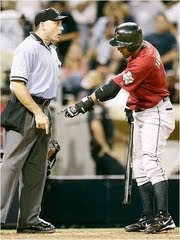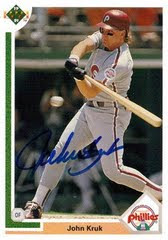Last week Forbes evaluated the value of each NFL franchise heading into the 2010-2011 season and showed the public how much each team is worth. I could break down each team and provide in depth analysis, but who would be kidding with me breaking down the economics of football. I just thought it was interesting to see where each NFL team was ranked and wanted to share it with you if you haven't see this story yet.
Here are the rankings according to the article by Forbes:
1 Dallas Cowboys
2 Washington Redskins
3 New England Patriots
4 New York Giants
5 Houston Texans
6 New York Jets
7 Philadelphia Eagles
8 Baltimore Ravens
9 Chicago Bears
10 Denver Broncos
11 Indianapolis Colts
12 Carolina Panthers
13 Tampa Bay Buccaneers
14 Green Bay Packers
15 Cleveland Browns
16 Miami Dolphins
17 Pittsburgh Steelers
18 Tennessee Titans
19 Seattle Seahawks
20 Kansas City Chiefs
21 New Orleans Saints
22 San Francisco 49ers
23 Arizona Cardinals
24 San Diego Chargers
25 Cincinnati Bengals
26 Atlanta Falcons
27 Detroit Lions
28 Buffalo Bills
29 St Louis Rams
30 Minnesota Vikings
31 Oakland Raiders
32 Jacksonville Jaguars
A few of the teams that stood out to me as being surprisingly high were: Washington Redskins at number 2, Houston Texans at 5, Baltimore Ravens at 8, Carolina Panthers at 12, and Cleveland Browns at 15. It was good to see these franchises so high.
Some of the teams I was surprised to be so low for the market or success of the team was Chicago Bears at 9, Green Bay Packers at 14, Pittsburgh Steelers at 17, Tennessee Titans at 18, Arizona Cardinals at 23, San Diego Chargers at 24, and the most shocking was the Minnesota Vikings at number 30! These teams I would have expected to be higher.
The Chicago Bears at number 9 had to be the most disappointing and I am not saying that as a Bears fan. Chicago is one of the biggest markets and it doesn't have two teams like New York. For these two reasons it should be higher. Thus, it should be in the top 3, or the top 5 to say the least.
Other great teams and storied franchises like the Green Bay Packers, Pittsburgh Steelers, San Diego Chargers, and Minnesota Vikings I would have thought to be much higher.
If you go to the article you can click on a team and read more about the appraisal for the team.
Showing posts with label Economics 101. Show all posts
Showing posts with label Economics 101. Show all posts
Forbes NFL Team Valuations
Posted by
Cubsfan4evr
on Sunday, September 5, 2010
Labels:
Chicago Bears,
Economics 101,
economy,
Forbes,
Money,
NFL
READ AND POST COMMENTS (0)
Russell Branyan & Structural Unemployment
Posted by
David "MVP" Eckstein
on Thursday, February 4, 2010
Structural unemployment results from a mismatch of workers and jobs. Even if there are an equal number of job vacancies and unemployed workers, the unemployed may lack the necessary skills for the specifically available jobs or they may not be in the right geographic location to fill the open positions (ie, unemployed guy who fits a job vacancy in NY lives in TX). Structural unemployment is the result of a changing economy; demands and needs change with time and perception. The scarcity of resources causes employers to reallocate their resources to produce more efficient outcomes. The result is that some skills become obsolete and other positions just plain disappear.
This economic term is quite prevalent in modern baseball. In the post-Moneyball world, teams have become "smarter" (well, teams not run by Omar Minaya, Dayton Moore, Ed Wade and Brian Sabean generally have) even though payrolls have generall expanded. Teams (again, those not run by Omar Minaya, Dayton Moore, Ed Wade and Brian Sabean) look less superficial statistics like ERA and BA and more at actual production. Teams have shyed away from spending big on aging players in their twilight years and on free-market influenced free agency players and they have focused more on drafting, acquiring and developing prospects. In the process of transition, some players who are still productive have been left in the dust. Players like Kenny Lofton were forced into retirement, while the market has completely dropped out for the Jim Thome's of the world. True, it is unwise to spend equal or more money on older players, even if they are comparably productive to younger players. However, this does not necessarily make the older players "useless." While it is not a bad idea to fill team holes with young, cost-controlled players who will provide equivalent value to what can be had on the free market at a fraction of the price, there are some very important factors to consider when deciding whether to go internal or external. What is the marginal WAR value between the internal player and the free agency player? How much extra will the external player cost? What is your team's competitive position?
When teams with a chance to make the playoffs are in a highly competitive environment, the marginal value of a win likely exceeds the market cost. Additionally, filling a hole with an internal +1.5 WAR, $400,000 player rather than a +4 WAR, $8 million dollar player seems silly. It is also silly to fill the DH role with a player whose cumulative value comes from his defense just because they are cheaper.
 Acknowledging all of this -- the economics and the questions which must be asked in determining whether to go the internal or free agency route -- I turn to Russell Branyan and ask why the Mets have not signed him. The Mets are a team with a strong enough core of expensive superstars to legitimately compete for a wild card berth if the team can stay health in 2010. Without the services of a Jose Reyes and Carlos Delgado, with only half-season from Johan Santana and Carlos Beltran, and without a productive David Wright last season, the Mets were a 70-92 team. Pretty lousy, but there's a lot of reason to think they're a +.500 team as built. If we double Johan's production from last season and add the value provided by the career average rates of Reyes, Beltran, and Wright, the Mets in theory gain +13 WAR.
Acknowledging all of this -- the economics and the questions which must be asked in determining whether to go the internal or free agency route -- I turn to Russell Branyan and ask why the Mets have not signed him. The Mets are a team with a strong enough core of expensive superstars to legitimately compete for a wild card berth if the team can stay health in 2010. Without the services of a Jose Reyes and Carlos Delgado, with only half-season from Johan Santana and Carlos Beltran, and without a productive David Wright last season, the Mets were a 70-92 team. Pretty lousy, but there's a lot of reason to think they're a +.500 team as built. If we double Johan's production from last season and add the value provided by the career average rates of Reyes, Beltran, and Wright, the Mets in theory gain +13 WAR.
With Carlos Delgado seemingly out of the picture (injury prone, aging, seeking too much money), the Mets have a hole at first base. The team seems content using David Murphy and Fernando Tatis platoon at first. CHONE pegs Murphy as a -4 bat and +1 glove per 150 games and Tatis as a -2 bat and +1 glove per 150 games. In a platoon, let's take the cumulative average at -2 runs. Factor in a -12.5 positional adjustment and +20.0 replacement adjustment and you've got a +1 WAR player at best.
Russell Branyan, meanwhile, is sitting in free agency without a job. Yes, the Mets probably don't want to touch an injury risk player with a 10 foot poll after 2009, but Branyan might be worth it. In 505 PA last season, Branyan put up a respectable +2.8 WAR, 31 HR season despite posting a brutal .688 OPS in 268 PA while playing with a back injury.
Despite the injury and ridiculously poor second half, Branyan still posted a quality .251/.347/.520 (.867 OPS, .368 wOBA) triple slash line with a .307 BABIP and .313 xBABIP. This says a .850 OPS, .360 wOBA season is not entirely implausible. Branyan is also a league average glove. CHONE forecasts Branyan as a +16 run bat and +0 run glove per 150 games. Add in the -12.5 positional and +20.0 replacement adjustments and you get a +2.5 WAR player.
After setting his sights high and seeking a 3-year, $20-30 million deal at the beginning of the offseason, Branyan is now willing to settle for a deal in the one-year, $3 million dollar range. The Mets, in effect, would gain +1.5 WAR (over Tatis/Murphy) by signing Branyan to play first at the marginal cost of $3 million. That would be less than the market value of a single WAR.
No matter how you slice it, this would be a good signing for the Mets. Branyan would add value to the team at a good price and even if the Mets don't end up in a competitive position by mid-season, they could trade the cost-controlled asset to a team who is. This late in the season, open 1B/DH roles are few and far between. The Mets make the most sense for Branyan and Branyan makes the most sense for the Mets. I'm shocked Minaya has not inquired on Branyan's services yet. Probably because Branyan is white.
This economic term is quite prevalent in modern baseball. In the post-Moneyball world, teams have become "smarter" (well, teams not run by Omar Minaya, Dayton Moore, Ed Wade and Brian Sabean generally have) even though payrolls have generall expanded. Teams (again, those not run by Omar Minaya, Dayton Moore, Ed Wade and Brian Sabean) look less superficial statistics like ERA and BA and more at actual production. Teams have shyed away from spending big on aging players in their twilight years and on free-market influenced free agency players and they have focused more on drafting, acquiring and developing prospects. In the process of transition, some players who are still productive have been left in the dust. Players like Kenny Lofton were forced into retirement, while the market has completely dropped out for the Jim Thome's of the world. True, it is unwise to spend equal or more money on older players, even if they are comparably productive to younger players. However, this does not necessarily make the older players "useless." While it is not a bad idea to fill team holes with young, cost-controlled players who will provide equivalent value to what can be had on the free market at a fraction of the price, there are some very important factors to consider when deciding whether to go internal or external. What is the marginal WAR value between the internal player and the free agency player? How much extra will the external player cost? What is your team's competitive position?
When teams with a chance to make the playoffs are in a highly competitive environment, the marginal value of a win likely exceeds the market cost. Additionally, filling a hole with an internal +1.5 WAR, $400,000 player rather than a +4 WAR, $8 million dollar player seems silly. It is also silly to fill the DH role with a player whose cumulative value comes from his defense just because they are cheaper.
 Acknowledging all of this -- the economics and the questions which must be asked in determining whether to go the internal or free agency route -- I turn to Russell Branyan and ask why the Mets have not signed him. The Mets are a team with a strong enough core of expensive superstars to legitimately compete for a wild card berth if the team can stay health in 2010. Without the services of a Jose Reyes and Carlos Delgado, with only half-season from Johan Santana and Carlos Beltran, and without a productive David Wright last season, the Mets were a 70-92 team. Pretty lousy, but there's a lot of reason to think they're a +.500 team as built. If we double Johan's production from last season and add the value provided by the career average rates of Reyes, Beltran, and Wright, the Mets in theory gain +13 WAR.
Acknowledging all of this -- the economics and the questions which must be asked in determining whether to go the internal or free agency route -- I turn to Russell Branyan and ask why the Mets have not signed him. The Mets are a team with a strong enough core of expensive superstars to legitimately compete for a wild card berth if the team can stay health in 2010. Without the services of a Jose Reyes and Carlos Delgado, with only half-season from Johan Santana and Carlos Beltran, and without a productive David Wright last season, the Mets were a 70-92 team. Pretty lousy, but there's a lot of reason to think they're a +.500 team as built. If we double Johan's production from last season and add the value provided by the career average rates of Reyes, Beltran, and Wright, the Mets in theory gain +13 WAR.With Carlos Delgado seemingly out of the picture (injury prone, aging, seeking too much money), the Mets have a hole at first base. The team seems content using David Murphy and Fernando Tatis platoon at first. CHONE pegs Murphy as a -4 bat and +1 glove per 150 games and Tatis as a -2 bat and +1 glove per 150 games. In a platoon, let's take the cumulative average at -2 runs. Factor in a -12.5 positional adjustment and +20.0 replacement adjustment and you've got a +1 WAR player at best.
Russell Branyan, meanwhile, is sitting in free agency without a job. Yes, the Mets probably don't want to touch an injury risk player with a 10 foot poll after 2009, but Branyan might be worth it. In 505 PA last season, Branyan put up a respectable +2.8 WAR, 31 HR season despite posting a brutal .688 OPS in 268 PA while playing with a back injury.
Despite the injury and ridiculously poor second half, Branyan still posted a quality .251/.347/.520 (.867 OPS, .368 wOBA) triple slash line with a .307 BABIP and .313 xBABIP. This says a .850 OPS, .360 wOBA season is not entirely implausible. Branyan is also a league average glove. CHONE forecasts Branyan as a +16 run bat and +0 run glove per 150 games. Add in the -12.5 positional and +20.0 replacement adjustments and you get a +2.5 WAR player.
After setting his sights high and seeking a 3-year, $20-30 million deal at the beginning of the offseason, Branyan is now willing to settle for a deal in the one-year, $3 million dollar range. The Mets, in effect, would gain +1.5 WAR (over Tatis/Murphy) by signing Branyan to play first at the marginal cost of $3 million. That would be less than the market value of a single WAR.
No matter how you slice it, this would be a good signing for the Mets. Branyan would add value to the team at a good price and even if the Mets don't end up in a competitive position by mid-season, they could trade the cost-controlled asset to a team who is. This late in the season, open 1B/DH roles are few and far between. The Mets make the most sense for Branyan and Branyan makes the most sense for the Mets. I'm shocked Minaya has not inquired on Branyan's services yet. Probably because Branyan is white.






